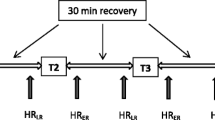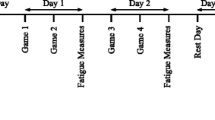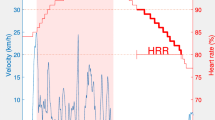Abstract
The objective of the present study was to verify if active recovery (AR) applied after a judo match resulted in a better performance when compared to passive recovery (PR) in three tasks varying in specificity to the judo and in measurement of work performed: four upper-body Wingate tests (WT); special judo fitness test (SJFT); another match. For this purpose, three studies were conducted. Sixteen highly trained judo athletes took part in study 1, 9 in study 2, and 12 in study 3. During AR judokas ran (15 min) at the velocity corresponding to 70% of 4 mmol l−1 blood lactate intensity (~50% \( \dot{V}\hbox{O}_{2} \) peak), while during PR they stayed seated at the competition area. The results indicated that the minimal recovery time reported in judo competitions (15 min) is long enough for sufficient recovery of WT performance and in a specific high-intensity test (SJFT). However, the odds ratio of winning a match increased ten times when a judoka performed AR and his opponent performed PR, but the cause of this phenomenon cannot be explained by changes in number of actions performed or by changes in match’s time structure.

Similar content being viewed by others

References
Artioli GG, Gualano B, Coelho DF, Benatti FB, Gailey AW, Lancha AH Jr (2007) Does sodium-bicarbonate ingestion improve simulated judo performance. Int J Sport Nutr Exerc Metab 17:206–217
Baldari C, Videira M, Madeira F, Sergio J, Guidetti L (2004) Lactate removal during active recovery related to the individual anaerobic and ventilatory thresholds in soccer players. Eur J Appl Physiol 93:224–230
Belcastro AN, Bonen A (1975) Lactic acid removal rates during controlled and uncontrolled recovery exercise. J Appl Physiol 39:932–935
Bogdanis GC, Nevill ME, Boobis LH, Lakomy HKA (1996) Contribution of phosphocreatine and aerobic metabolism to energy supply during repeated sprint exercise. J Appl Physiol 80:876–884
Bond V, Adams RG, Tearney RJ, Gresham K, Ruff W (1991) Effects of active and passive recovery on lactate removal and subsequent isokinetic muscle function. J Sports Med Phys Fitness 31:357–361
Bonen A, Belcastro AN (1976) Comparison of self-selected recovery methods on lactic acid removal rates. Med Sci Sports Exerc 8:176–178
Castarlenas JL, Planas A (1997) Estudio de la estructura temporal del combate de judo. Apunts: Educ Fís Deportes 47:32–39
Chmura J, Nazar K, Kaciuba-Uscilko H (1994) Choice reaction time during graded exercise in relation to blood lactate and catecholamine thresholds. Int J Sports Med 15:172–176
Chmura J, Krysztofiak H, Ziemba AW, Nazar K, Kaciuba-Uscilko H (1998) Psychomotor performance during prolonged exercise above and below the blood lactate threshold. Eur J Appl Physiol 77:77–80
di Prampero PE, Ferretti G (1999) The energetics of anaerobic muscle metabolism: a reappraisal of older and recent concepts. Respir Physiol 118:103–115
Dodd S, Powers SK, Callender T, Brooks E (1984) Blood lactate disappearance at various intensities of recovery exercise. J Appl Physiol 57:1462–1465
Franchini E, Nakamura FY, Takito MY, Kiss MAPDM, Sterkowicz S (1998) Specific fitness test developed in Brazilian judoists. Biol Sport 15:165–170
Franchini E, Takito MY, Nakamura FY, Matsushigue KA, Kiss MAPDM (2003) Effects of recovery type after a judo combat on blood lactate removal and on performance in an intermittent anaerobic task. J Sports Med Phys Fitness 43:424–431
Franchini E, Nunes AV, Moraes JM, Vecchio FB (2007) Physical fitness and anthropometrical profile of the Brazilian male judo team. J Physiol Anthrop 26:59–67
Gaitanos GC, Williams C, Boobis LH, Brooks S (1993) Human muscle metabolism during intermittent maximal exercise. J Appl Physiol 75:712–719
Greenwood JD, Moses ED, Bernardino FM, Gaesser GA, Weltman A (2008) Intensity of exercise recovery, blood lactate disappearance, and subsequent swimming performance. J Sports Sci 26:29–34
Gupta S, Goswami A, Sadhukhan AK, Mathur DN (1996) Comparative study of lactate removal in short term massage of extremities, active recovery and a passive recovery period after supramaximal exercises sessions. Int J Sports Med 17:106–110
Heck H, Mader A, Hess G, Mucke S, Muller R, Hollmann W (1985) Justification of 4 mmol/l lactate threshold. Int J Sports Med 6:117–130
Hemmings B, Smith M, Graydon J, Dyson R (2000) Effects of massage on physiological restoration, perceived recovery, and repeated sports performance. Br J Sports Med 34:109–115
Hermansen L, Stensvold I (1972) Production and removal of lactate during exercise in man. Acta Physiol Scand 86:191–201
Hudson OD, Loy SF, Vincent WJ, Yaspelkis BB (1999) Blood lactate concentration and rated perceived exertion following active recovery in water. Sports Med Train Rehab 9:41–50
Kashihara K, Nakahara Y (2005) Short-term effect of physical exercise at lactate threshold on choice reaction time. Percept Mot Skills 100:275–291
Majean H, Gaillat ML (1986) Étude de l’acide lactique sanguin chez le judoka en fonction des méthodes d’entraînement. Med Sport 60:194–203
Marcon G, Franchini E, Vieira DEB, Barros TL (2007) Time structure and activities performed during a judo match. In: Del’Vecchio FB, Franchini E (eds) Annals of the 5th international judo federation world research symposium. International Judo Federation, p 49
McAinch AJ, Febbraio MA, Parkin JM, Zhao S, Tangalakis K, Stojanovska L, Carey M (2004) Effect of active versus passive recovery on metabolism and performance during subsequent exercise. Int J Sport Nutr Exerc Metab 14:185–196
McLellan TM, Skinner JS (1982) Blood lactate removal during recovery related to the aerobic threshold. Int J Sports Med 3:224–229
McMorris T, Delves S, Sproule J, Lauder M, Hale B (2005) Effect of incremental exercise on initiation and movement times in a choice response, whole body psychomotor task. Br J Sports Med 39:537–541
Monedero J, Donne B (2000) Effect of recovery interventions on lactate removal and subsequent performance. Int J Sports Med 21:593–597
Muramatsu S, Horiyasu T, Sato SI, Hattori Y, Yanagisawa H, Onozawa K, Tezuka M (1994) The relationship between aerobic capacity and peak power during intermittent anaerobic exercise of judo athletes. Bull Assoc Sci Study Judo 8:151–160
Siegler JC, Bell-Wilson J, Mermier C, Faria E, Robergs RA (2006) Active and passive recovery and acid-base kinetics following multiple bouts of intense exercise to exhaustion. Int J Sport Nutr Exerc Metab 16:92–107
Sikorski W, Mickiewicz G, Majle B, Laksa C (1987) Structure of the contest and work capacity of the judoist. In: European Judo union proceedings of the international congress on judo “contemporary problems of training and judo contest”. Spala, European Judo Union, pp 58–65
Spriet LL, Lindinger MI, McKelvie RS, Heigenhauser GJF, Jones NL (1989) Muscle glycogenolysis and H+ concentration during maximal intermittent cycling. J Appl Physiol 66:8–13
Stamford BA, Weltman A, Moffatt R, Sady S (1981) Exercise recovery above and below anaerobic threshold following maximal work. J Appl Physiol 51:840–844
Sterkowicz S (1995) Test specjalnej sprawnoci ruchowej w judo. Antropomotoryka 12:29–44
Sterkowicz S, Garcia JMG, Lerma FS (2007) The importance of judo trainers’ professional activities. Arch Budo 3:57–61
Thiriet P, Gozal D, Wouassi D, Oumarou T, Gelas H, Lacour JR (1993) The effect of various recovery modalities on subsequent performance, in consecutive supramaximal exercise. J Sports Med Phys Fitness 33:118–129
Thomas SG, Cox MH, Legal YM, Verde TJ, Smith HK (1989) Physiological profiles of the Canadian National Judo Team. Can J Sport Sci 14:142–147
Thomas P, Goubault C, Beau MC (1990) Judokas: évolution de la lactatémie au cours de randoris successifs. Med Sport 64:234–236
Trump ME, Heigenhauser JF, Putman CT, Spriet LL (1996) Importance of muscle phosphocreatine during intermittent maximal cycling. J Appl Physiol 80:1574–1580
Tumilty DM, Hahn AG, Telford RD (1986) A physiological profile of well-trained male judo players. In: Watkins J, Reilly T, Burwitz L (eds) Proceedings of the VIII commonwealth and international conference on sport, physical education, dance, recreation, and health. E & F.N. Spon, London, pp 3–10
Van Malderen K, Jacobs C, Ramon K, Evert Z, Deriemaeker P, Clarys P (2006) Time and technique analysis of a judo fight: a comparison between males and females. In: Hopeler H et al (eds) Book of abstracts of the 11th annual congress of the European college of sport science, p 101
Watts PB, Daggett M, Gallagher P, Wilkins B (2000) Metabolic response during sport rock climbing and the effects of active versus passive recovery. Int J Sports Med 21:185–190
Weltman A, Regan JD (1983) Prior exhaustive exercise and subsequent, maximal constant load exercise performance. Int J Sports Med 4:184–189
Weltman A, Stamford BA, Moffat RJ, Katch VL (1977) Exercise recovery, lactate removal, and subsequent high intensity exercise performance. Res Q 48:786–796
Weltman A, Stamford BA, Fulco C (1979) Recovery from maximal effort exercise: lactate disappearance and subsequent performance. J Appl Physiol 47:677–682
Acknowledgments
We would like to thank all subjects and their coaches for their committed participation. This study was supported by a grant from Fundação de Amparo à Pesquisa do Estado de São Paulo (99/06408-2).
Author information
Authors and Affiliations
Corresponding author
Rights and permissions
About this article
Cite this article
Franchini, E., de Moraes Bertuzzi, R.C., Takito, M.Y. et al. Effects of recovery type after a judo match on blood lactate and performance in specific and non-specific judo tasks. Eur J Appl Physiol 107, 377–383 (2009). https://doi.org/10.1007/s00421-009-1134-2
Accepted:
Published:
Issue Date:
DOI: https://doi.org/10.1007/s00421-009-1134-2



